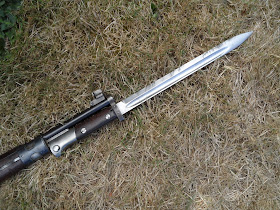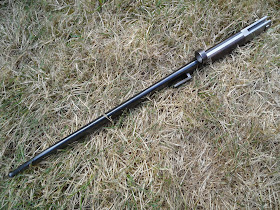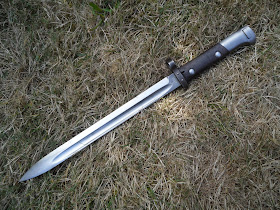The VZ24 bayonets are not uncommon and it is thought that the Czech's manufactured several hundred thousand of these over the years! Even though they are a "common" bayonet, that does not take away from their quality, and beauty.
The most unique feature on these bayonets is the "reversed blade". When you first look at a Czech VZ24 bayonet, it looks like any other Mauser bayonet of the era, however, on closer inspection, it is apparent that the cutting edge is on the TOP of the blade! It is not known why this blade configuration was chosen, but it is quite unique and distinctive.
Manufacture of these bayonets started in 1924, with the first production of the VZ24 Rifles and continued through until the end of WW2 with only a few variations.
The first variation that you are apt to encounter is the VZ24 bayonet that has had the muzzle ring ground off so that it resembles the German K98 Bayonet.
The next variation is a VZ24 bayonet that was manufactured without the muzzle ring.
When the Germans invaded and captured Czechoslovakia, in 1939, they took control of the Czech firearm factories. The Germans took control of vast numbers of VZ24 rifles and existing bayonets. The Germans issued and used the Czech rifles and bayonets throughout WW2 and often entire military units were issued the Czech VZ24 rifles and bayonets instead of the German K98 Mausers.
 |
| German soldier carrying VZ24 Rifle, bayonet with muzzle ring, and Czech shovel. |
I am not certain of the exact date that production changed from producing bayonets with muzzle rings to those without, but I would assume it was shortly after Czechoslovakia was taken over by the Germans in 1939.
The Czech VZ24 bayonets with the muzzle rings, are not stamped with the date of manufacture, however, there is a Czech Army acceptance stamp that has the date the bayonet was put into military service. It would be assumed that this date would very closely approximate the production year of the bayonet.
My bayonet is stamped with CSZ on the bayonet, indicating that it was manufactured by the Czech State Armory, "Ceskoslovenska Zbrojovka". The meaning of the letter B under the CSZ stamp is unknown, however I would guess that it corresponded to a "batch run" of bayonets. These bayonets can be dated to a "time period" based on which side of the blade the CSZ is stamped on. 1923-1937 on the left, and then switched to the right side in 1938. My bayonet falls into the 1923-1937 period, which matches the 1936 date on the scabbard.
The scabbard is stamped with the Czech Military Acceptance Stamp, a Bohemian Lion with the year code for 1936., as well as CSZ indicating the Czech State Armory for manufacture.
Let's take a look at a few more photos of this unique bayonet.

















The stamp "S" under The CSZ stand on The blade....
ReplyDeleteThe only visible markings I can make out is a Z with swirls in a circle. Can you tell me about that marking could it be a replica?
ReplyDeletedo you know what the "S" stands for??"
ReplyDeletePrague Castle Guard -Presidents honour guard
http://www.old-smithy.info/bayonets/HTNL%20DOCUMNETS/czechoslovak_bayonet_markings.htm
I have one of these, not a collector but would like to care for it. It is starting to rust and the wood is swelling... Advice?
ReplyDeleteYou say, "It is starting to rust and the wood is swelling... Advice?"
ReplyDeleteKeep the bayonet in a dry place (Do you live in a swamp?) should make the wood dry out and shrink back. You can also rub the wood with a cloth wetted with some xylene or other solvent/remover like Goof Off (not Goo Gone). Use protective gloves.
Lots of rubbing (by green pad, sandpaper, abrasive pastes, etc.) will tend to wear down the distinct lines in the metal and make your bayonet look worn. It's your call whether you get aggressive to remove the rust.
But getting some RIG Rust Inhibiting Grease from Brownells or ebay and smearing a thin coating on the metal, and repeating every six months, will stop the rusting.
You can also try all of the newer Break Free CLP, Ballistol et al. that the young kids use. I never have but I'd say that probably the only thing they have over the RIG is much better advertising. (CLP Cleans, Lubricates, Preserves. You know what they say about a multi-use compound: Doesn't do any of the uses particularly well.)
Csz with a D
ReplyDeleteHello,
ReplyDeleteAs for the inverted blade see, Czech VZ-22
https://worldbayonets.com/Bayonet_Identification_Guide/Czechoslovakia/Czechoslovakia_2.html
And Austria M1895,
https://worldbayonets.com/Bayonet_Identification_Guide/Austria/Austria_2.html
Inverting the blades started with the Austrians M1895.
Thanks,
Hi, For the Z mark in swirl. See VZ-24,
ReplyDeletehttps://worldbayonets.com/Bayonet_Identification_Guide/Czechoslovakia/Czechoslovakia_2.html#czech_post_war_vz_24
The Z is in a rifle bore, trademark since 1928.
Thanks,
do you have a source for the photo
ReplyDelete"Inverted" blade has very simple reason - when you push rifle with bayonet into body (preferably soft belly), you naturally pull up.
ReplyDeleteSo blade can open up the wound and get out easier.
"The meaning of the letter B under the CSZ stamp is unknown"
ReplyDelete"The weapons were marked with the unit body and the registration number of the weapon. This was done on the basis of the decree of the Department of Economics of the Armory of the Military Department MNO file No. 536735 of July 1922. In recent years, it was the duty to designate the weapons enshrined in D-XIII-3 "Maintenance and Armory repair. This mark consisted of a body number, name abbreviations, usually 1 to 3 letters, and a weapon registration number. The corresponding mark was also embossed on a circular tag attached to the butt of the rifle to which the bayonet belonged.
Department abbreviations:
A = Automobile Battalions
AD = Auto Department of Artillery
AZ = Automotive Arsenal
BS = Military Prosecutor of the Brigade Court
C = Battalions of cyclists
D = Artillery regiments
DOV = District of Parts Command
DPLV = Antiaircraft Artillery Regiment
DPS = Division of Supply Warehouses
DSH = Humenné Training Camp (Prešov, Slovakia)
DSJ = Jince Čenkov Training Camp (Příbram, Czech Republic)
DSP = Plavecké Podhradie Training Camp (Malacky, Slovakia)
DSV = Vyškov Training Camp (South Moravia, Czech Republic)
DZ = Armory Division
G = Moravská Třebová Royal State Reformed Secondary Military School (Svitavy, Czech Republic)
H = Mountain Infantry Regiments
HB = Command of the Mountain Brigades HDB = Command of the Major Artillery Brigade HLD = Main Aviation Workshops
HLS = Main Aviation Depot
HN = Border Battalions
HTS = Main Telegraph Warehouse
HVS = Main Car Warehouse
HZLS = Main Railway Warehouse
HZNS = Main Engine Warehouse
HZS = Main Firearms Warehouse
IP = Instruction Battalion
IS = Service Graduation School
J = Riding Regiment
JB = Commando Riding Brigade
L = Air Regiments
LDB = Light Artillery Brigade Command
M = Company for the Replacement of Artillery Elements
MT = Ammunition Factory
OS = Logistics
P = Infantry Regiments
PB = Infantry Brigade Command
PD = Infantry Division Command
PDB = Field Artillery Command - Storm Tank Regiments Brigade (originally storm tank battalions)
PV = Armored Train
PZ = Health Care Team
S = Headframe Guard
SP = Mechanics Battalion
SRB = Company Personnel with Military Headquarters in Brno
SRBR = Company Personnel Z.V.V. in Bratislava
SRM = Company Personnel MNO
SRP = Company Personnel Z.V.V. in Prague
SRU = Personnel of the Company Z.V.V. in Uzhgorod (western Ukraine)
T = Telegraph Battalions
TDB = Heavy Artillery Brigade Command
TS = School of Physical Education
UA = School of Automobiles
UD = Artillery Training and Instruction Section
UJ = Riding School
UL = Aviation School
UP = Infantry School
UT = School of Telegraphy
UUV = Assault Tank School
UV = Assault Tank Division
UZ and UZN = School of Engineering
V = Tank Battalions
VA = Military Academy
VAM = War Archives and Museum
VEK = Military Horse Regiment
VH = Military Cavalry
Vchu = Institute of Military Chemistry
VMT = Military Ammunition Factory
VP = Aquatic Battalion
VPB = Bratislava Military Police
VS = Higher Military School
VT = Military Penitentiary
VTLU = Military Technical and Aerospace Institute
VV = Military Prison
VZS = Military Medical Warehouse
VZU = Military Geographical Institute
Z = Military Supplies
ZL = Railway Regiment
ZLS = Aviation Ground Warehouse
ZN = Engineer Regiments
ZU = Military Geographical Institute
ZZ = Army Armory "
My bayonet has just a single "O" below the CSZ. I dont see it on your list. Any ideas?
ReplyDelete